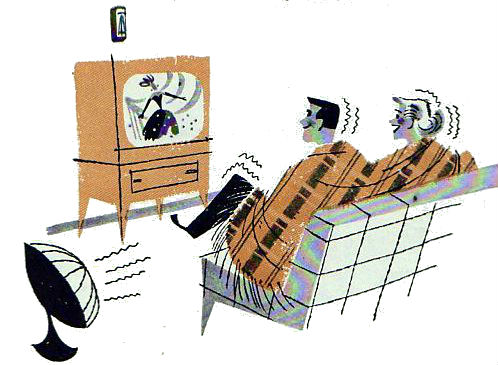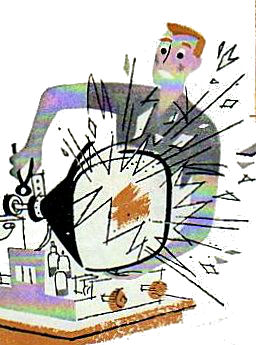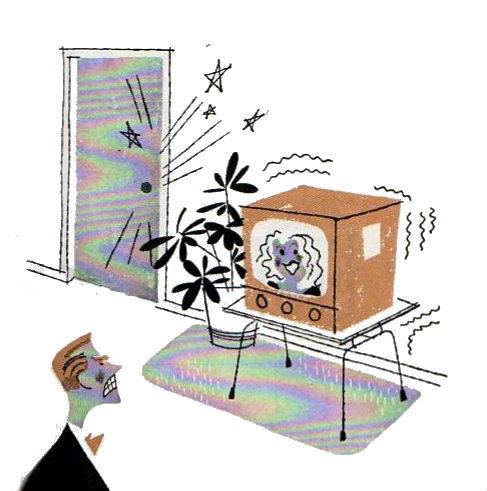In the 1950′s, television had become a popular way for people to spend their free time.
Not only did families sit down together to watch the TV, people also held Saturday night parties for friends to gather together to view the shows.
But television was not all carefree fun. Television sets broke down, had complicated switches that did who knew what, and experienced interference for a variety of reasons. Thus, the June 1953 issue of American Home magazine presented an article titled “How to Care for your TV Set”, full of tips for TV owners to keep things running smoothly. The great retro illustrations in this blog post also come from this article.
“A great number of the 17 million TV sets now in use are five years of age or older, and every year millions of others become middle aged. When this happens, more and more parts need replacement.”
For this reason, in this article, “Researchers asked a dozen of the country’s foremost authorities – manufacturers and maintenance experts of the nation’s most respected brands – to tell what the average American can do to keep performance high and repair bills low. Their following easy-to-follow suggestions will improve reception, lengthen your set’s life, and protect you against needlessly high bills when repairs are necessary.”
1) Understand the Simple Principles of TV.
The article then goes on to provide a lengthy description of how exactly TV signals work to get the picture on your screen. “If you keep this operation in mind, you will realize that every device from the antenna to the picture tube is important to good TV reception, and that for best results, every part should be kept in good working order.”
2) Recognize TV’s Limitations.
“Learn to recognize the common causes of temporary interference about which you can do nothing. Automobile motors running nearby will produce a speckled, streaked picture… Other radio signals transmitted nearby will produce moving ripples or diagonal streaks.
“One night recently, a home owner in a New York suburb settled back to enjoy his new set. Every few minutes, however, the picture became wavy and weak. The owner awakened his serviceman then and there to complain, but the cause was beyond anybody’s control: commercial airliners, flying to a nearby airport, cut across the path of signals from the broadcasting station and caused the interference. In such cases, the TV owner must learn to bear momentary inconvenience – or move away.”
3) Place Your Receiver with Care.
“An all-too-common error, says one authority, is placing the set too close to windows, radiators, or warm air registers. Excessive cold, heat, or dampness will upset its intricate mechanism. Once you find the best position, don’t move your set unnecessarily, for moving it upsets certain adjustments. Also, avoid slamming doors in your TV room.”
4) Check Your Antenna Regularly.
“No set is better than its antenna,” experts agree. “Is [your antenna] in the best location?.. Is it securely attached?… Does it often “snow” on your screen? This may be due to a weak signal. With more elements added, your antenna could produce a stronger signal. For an investment of about $20 or so, you can usually increase by ten times the signal receiving power of your antenna.”
5) Learn to Work Your Set’s Controls.
“These are of two types: those on the front which you operate to turn the receiver on and off, to select the stations, to regulate sound volume and picture brightness, and to keep the picture image from moving up and down or sideways. And there are the other controls (usually on the back) which should be touched only in case of trouble.
“Most TV owners operate the everyday, front-of-set controls proficiently, but many persons, even those who have owned sets for years, are unaware of the fact that they can adjust the other controls to improve their TV reception.”
6) Don’t Be Shocked!
“Almost all manufacturers now place a covering at the back of the cabinet. Unless you remove this, you cannot reach into the chasis. On new sets, this vitally important interlock covering prevents tampering with the chassis while the switch is on, because when it is removed it automatically shuts off the electrical current. Thus it prevents you against the power – which in some sets reaches 27,000 volts – built up inside and extremely dangerous if you come into direct contact with it.”
7) Don’t Tamper with the Picture Tube!
“Never violate this rule...Foolhardy amateurs could suffer severe cuts and shock by mishandling the picture tube.”
8) Don’t Turn Switches Needlessly.
“Most youngsters flick the master switch on and off and needlessly tune from station to station. Experts explain that this causes undue wear on the picture tube.”
9) Investigate Your Serviceman.
“Caution in selecting a serviceman will pay dividends whether you sign a yearly contract or call him for a single repair job. Most television repairmen are anxious to be known as competent, reasonably priced workmen. Since the war, however, hundreds of unscrupulous servicemen have set up businesses, charging exorbitant fees by exploiting the average person’s ignorance about television.”
And a final reminder from the author – “In television maintenance, the cheapest will often prove the costliest in the long run.”







{ 0 comments… add one }